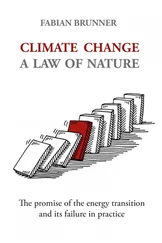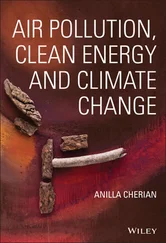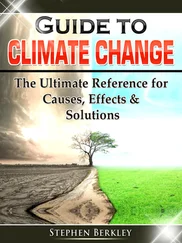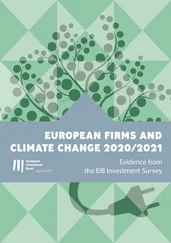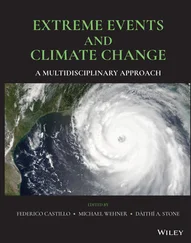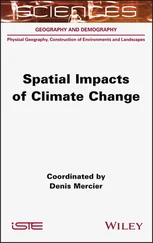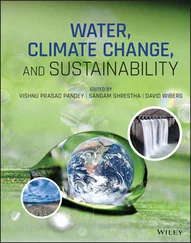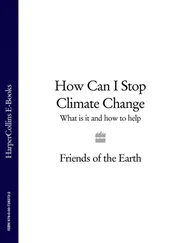Unfortunately, getting sulfur hexafluoride out of Nike runners didn’t eliminate all sources. Sulfur hexafluoride levels in the atmosphere continue to rise due to its use in the electricity sector. Concentrations of sulfur hexafluoride have been creeping up by about 0.36 parts per trillion (ppt) per year. In 2021, it made up 10.66 ppt of our atmosphere.
Chapter 3
Recognizing the Big Deal about Carbon
IN THIS CHAPTER
 Looking into what else contributes to climate change
Looking into what else contributes to climate change
 Linking carbon dioxide to temperature trends
Linking carbon dioxide to temperature trends
 Understanding what happens when the temperature becomes too hot to handle
Understanding what happens when the temperature becomes too hot to handle
 Limiting greenhouse gas emissions
Limiting greenhouse gas emissions
Elizabeth and Zöe Caron wrote Global Warming For Dummies in 2009. Back then, the consensus of the world’s scientists was that
Climate change was caused by rising carbon and other greenhouse gases (GHGs) emitted to the atmosphere ss a result of human activity.
Climate change could become irreversible and catastrophic if emissions kept increasing.
The use of fossil fuels had to be reduced drastically.
The solid worldwide scientific consensus has only been reinforced since then. And now the consensus isn’t just among scientists — it has become common understanding. Humans are having real-time experiences of floods, fires, droughts, heatwaves, and other disasters. The worst-case projections for the speed and magnitude have turned out to be not worse enough.
Still, even though the science is settled, scientists still say global warming is a theory . A scientific theory is based on a set of principles that describe a particular phenomenon — Newton’s so-called “law of gravity” is properly called his “theory of gravity.” Theories aren’t technically facts, but sometimes theories become so strong that people accept them as facts.
But how do you know this theory of GHG emissions causing climate change is correct? Can you really trust all those bigwig scientists? And if it’s correct, what does this theory suggest is going to happen next? We answer those questions in this chapter.
Considering Other Causes of Global Warming
Sure, some uncertainty exists around exactly where the global climate system will hit tipping points in the atmosphere, how global changes will affect local weather, or how much of it is due to human activity. What if GHGs aren’t the only culprits behind climate change?
The climate is an incredibly complex system affected by the sun, cloud cover, and complex long-term trend. In this section, you read about possible other drivers for climate change and see why no other has nearly the effect of GHG emissions from burning fossil fuels.
 The Intergovernmental Panel on Climate Change (IPCC) says that it’s 99 percent certain that increasing carbon dioxide levels due to human activity are the major cause of climate change. The IPCC says that there’s less than a 1 percent chance that climate change is being caused by natural factors.
The Intergovernmental Panel on Climate Change (IPCC) says that it’s 99 percent certain that increasing carbon dioxide levels due to human activity are the major cause of climate change. The IPCC says that there’s less than a 1 percent chance that climate change is being caused by natural factors.
So, although some uncertainty exists, the debate on the human contribution is largely settled. With that said, some natural climate change drivers need discussion. That’s largely because, over the years, these natural climate change drivers have been advanced to counter the growing consensus that human activity, primarily by burning fossil fuels and cutting forests, is the primary cause of dangerous changes in our global climate system. Putting the other natural culprits in the following sections aside is key to focusing on what humanity must do to preserve a habitable planet.
Solar cycles — Irradiance and Milankovitch
The sun has different cycles, and the Earth’s climate changes over time in response to these cycles. The sun goes through irradiance cycles, when the amount of solar radiation reaching the Earth varies. Scientists were only able to measure these cycles with precision after 1978 and the advent of satellites. Two of these cycles seem to exist, one running for 11 years and the other running for 22 years.
The solar cycles do affect climate in the short term, but the U.S. National Oceanic and Atmospheric Administration (NOAA) reports that the impact from the light intensity of the sun versus the impact from GHG emissions is a ratio of approximately 9 to 40. So, GHGs have more than four times the effect of solar cycles.
Other cycles that concern the sun are the Milankovitch cycles. Although they sound like Mr. Milankovitch’s bike collection, Milankovitch cycles are actually natural cycles of the Earth — one of these cycles, for example, is the way in which the planet tilts toward or away from the sun. These cycles may explain the glacial cycles — the ins and outs of ice ages. (We talk about the Milankovitch cycles in more detail in the section “ Making the Case for Carbon,” later in this chapter.)
Although they’re important, the Milankovitch cycles have minimal effect on climate in comparison to the effects from GHG emissions when you look at them in terms of relatively short timescales — from decades to centuries. Overall, the IPCC says that the sun likely has little to do with global average temperature rises since 1950. In fact, computer models suggest that the Earth would be cooling if not for increases in GHGs.
Scientists have known for a long time that climate affects rainfall. NASA (the National Aeronautics and Space Administration in the United States) has shown that the relationship may work in reverse, however — that the changing rain patterns might, in turn, indirectly affect global warming. Rainfall patterns correspond to cloud cover. Depending on their thickness and shape, clouds can reflect light during the day and hold in surface heat overnight (see Figure 3-1). The amount of water vapor in the air has continued to increase (which we talk about in Chapter 2), which means more clouds, which means more rainfall. Perhaps this increase in cloud cover can explain why nighttime temperatures are rising more than daytime temperatures in global warming trends. It gives a whole new meaning to having a hot night!
Ultimately, however, increased cloud cover seems to be a result, not a cause, of climate change. But, like the increased water vapor, it may further contribute to global warming.
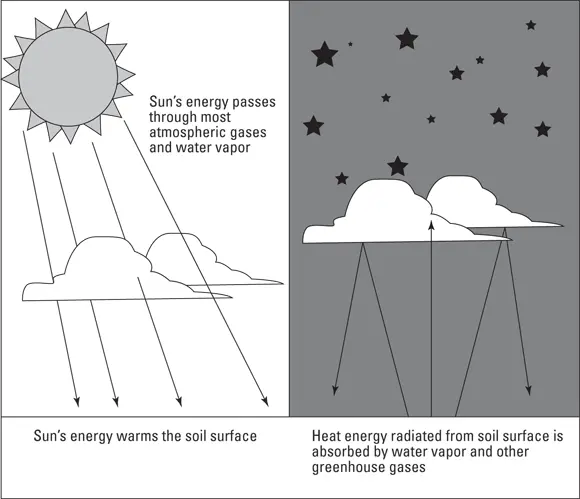
© John Wiley & Sons, Inc.
FIGURE 3-1:Clouds reflect light during the day and hold in surface heat overnight.
Over the course of many millions of years, the Earth’s temperature has varied widely. Scientists know that the most recent period of ice ages started about 2 million years ago, and since 800,000 years ago, the planet started into a cycle of an ice age every 100,000 years or so. Currently, the Earth is in an interglacial period — meaning the weather is warm and stable enough that humans can develop and expand societies. Human civilization started at the beginning of this interglacial period about 10,000 years ago. Given that past warm interglacial periods lasted about 10,000 years, on average, scientists would expect the world to be getting cooler, not warmer. In fact, it appears that this cooling was happening between the middle ages and the 19th century (the little ice age), but then came the Industrial Revolution.
Читать дальше
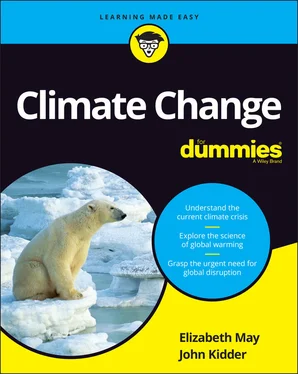
 Looking into what else contributes to climate change
Looking into what else contributes to climate change The Intergovernmental Panel on Climate Change (IPCC) says that it’s 99 percent certain that increasing carbon dioxide levels due to human activity are the major cause of climate change. The IPCC says that there’s less than a 1 percent chance that climate change is being caused by natural factors.
The Intergovernmental Panel on Climate Change (IPCC) says that it’s 99 percent certain that increasing carbon dioxide levels due to human activity are the major cause of climate change. The IPCC says that there’s less than a 1 percent chance that climate change is being caused by natural factors.
